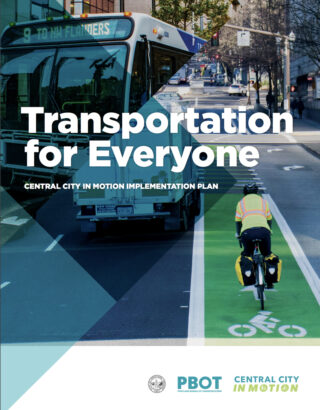City Council will get its first chance to debate the Central City in Motion plan this Thursday.
The Portland Bureau of Transportation (PBOT) hopes commissioners will approve their list of 18 projects they say will vastly increase capacity of streets from the Pearl to the Lloyd, and from southwest to the central eastside. PBOT’s argument is that growth of our central city makes squeezing more efficiency out of our existing roads imperative — and we can only do that by making cycling and transit easier and faster.
But if this plan is to get through council it will need support from local transportation advocacy groups. Three in particular have watched this plan closely as it has taken shape over the past several years: Bike Loud PDX, The Street Trust, and Portlanders for Parking Reform.
Below is a taste of the tone you can expect from each group on Thursday…
Bike Loud PDX
In some ways the CCIM plan will be a coming-of-age for Bike Loud. The group has given PBOT extensive feedback on the project, culminating in a 20-page letter sent to the agency in September and an update on the plan from PBOT Project Manager Gabe Graff at the group’s monthly meeting last week.
Here’s the testimony Bike Loud will share Thursday:
For too many years, Portlanders have seen the cities around them implement bold plans for biking and transit, while we rest on our accomplishments from another decade. Paris converted a waterfront highway to a public plaza, Seattle is one of three cities in the country with increased transit use. Our bicycle mode share is stuck at 6%, the same as it was in 2011, and transit ridership continues to fall. Our policies and plans are still visionary, but we have not matched our words with action.
The Central City in Motion Plan alone will not solve these issues. PBOT’s own estimates, show that with this plan we estimate the number of people walking, biking, or taking transit in the Central City will increase from 40% today, to 60% by 2035, still short of our 85% goal. We acknowledge these additional routes for non-motorized travel are not dense enough to pass our metric as a complete bike network. We should test these 18 projects ASAP, so we can determine what else needs to be done to achieve our 85% goal, and quickly program those additional strategies for rapid deployment once they are identified.
But this is an excellent start. We urge PBOT staff to implement these street designs as quickly as possible with temporary measures so residents and businesses alike can experience the benefits of these spaces. This plan groups the projects into those to be built within 5 years, and those to be built within 10 years. We instead urge Council to group the projects into those to be deployed within 12 months, and those to be deployed within 24 months; all 18 projects should be use-able by the end of 2020. This is possible using temporary strategies. Permanent solutions are OK to build out over the coming decade, but we need to implement this network now, not wait for all of the delays associated with full public works / capital project permitting, bidding and construction processes.
The world is changing quickly – the latest data from the e-scooter pilot showed over 600,000 trips so far. Making better roadways for these devices, and the ones coming in the future is of the utmost urgency. We look forward to working with staff at PBOT on the details on each of these projects.
You have the opportunity today to show your unanimous support for Portland values. Voting for Central City in Motion is a vote for climate action, for safer streets, for less pollution. Today we can begin a new era of Portland leadership on climate and green transportation.
The Street Trust
The Street Trust is also a huge fan of the projects outlined in the plan. In part, they say, because, “people will love them.” The Street Trust detailed other reasons in a letter by Executive Director Jillian Detweiler to Mayor Ted Wheeler and commissioners yesterday. Here are the highlights:
“The resolution adopting the plan outlines an amazing body of policy adopted by the City Council… None of these policies are worth anything if they are not supported by investments in walking, biking, and transit. It is time to move from great policy to great projects. It is not physically possible to support the growth proposed for the central city without shifting transportation choices to walking, biking, and transit. By allocating approximately 1 percent of city streets to non-autos, Central City in Motion projects will significantly increase the capacity of the transportation network… The Central City in Motion projects will chip away at the barriers to choosing alternatives to driving.
The Street Trust encounters all sorts of people in its work. Some are willing to travel out of direction, weather the discomfort of riding in traffic and test their patience to get to where they need to go by walking, biking or transit. Some have no choice but to do so. These are the people who are keeping the city moving by reducing cars on the road. They should be appreciated, but not taken for granted. Many more people say they would choose to walk if accessibility were guaranteed; choose to bike if they felt safe; choose to take transit if it did not take so darn long.
… as we are able to acquire most of the stuff we need and conduct more and more business online, the economic underpinning of a city — proximity — is eroding. An exceptional experience for people will maintain the value of our city. Investments in walking, biking, and transit will get cars off the road and make our city a memorable, hospital place designed for people.
People who have experienced the degradation of walking, biking and riding transit by traffic in recent years and those who have moved here expecting that alternatives to driving would be superior are frustrated and disappointed. Central City in Motion projects will help align our streets with our policies and rhetoric… We think motorists will also come to appreciate the separation of modes these projects will promote because no one likes being confused about how a street is intended to work.”
The Street Trust also says they want more data and clear project timelines to help hold PBOT accountable, and that transparency is needed to “ensure that investments in Central City in Motion to not consume a disproportionate share of transportation resources.” Detweiler was also a member of the plan’s Sounding Board committee and has spoken about the plan with commissioners’ staff and Mayor Wheeler.
Portlanders for Parking Reform
Parking looms large in this plan because a significant amount of street space currently to park cars (and as loading zones) will be re-allocated to lanes for biking and transit. When all 18 projects are built, PBOT estimates there will be 1,000 fewer curbside spaces for parking and loading (from 20,328 to 19,328).
That is no small thing in a city where battles have been fought over the loss of just a few parking spaces. To thwart potential pushback, PBOT has created a detailed, 29-page parking loss mitigation strategy that is on Thursday’s meeting agenda as a separate ordinance. Portlanders for Parking Reform has worked with PBOT on many issues over the years, but they were shocked when the agency released this strategy less than a week before the council hearing and without any broad public input. Now they’re crying foul.
In an article just posted this morning, the group says the plan has acquired a “parking parasite,” and characterized the parking strategy as a “backdoor plan to spend public money on parking garages… cynically tied to a long-awaited project to reduce car trips.”
Portlanders for Parking Reform (PPR) says the parking strategy was created with input “mostly from business interests”. “It does not appear that any community groups, transportation advocacy organizations, or neighborhood groups were brought into the process.” The group also says any move toward funding more auto parking in the central city is a bad investment will only lead to more congestion. PPR wants people to testify against parking subsidies and instead urge council members to focus on “transportation demand management” strategies like encouraging use of transit and bike share.
———
The level of input from each of these groups illustrates the importance of this plan.
Stay tuned for coverage of how the relatively small proposed tweaks to our streets can yield major results.
— Jonathan Maus: (503) 706-8804, @jonathan_maus on Twitter and jonathan@bikeportland.org
Get this post delivered directly to your inbox.
BikePortland needs your support.
The post What three advocacy groups think of the Central City in Motion plan appeared first on BikePortland.org.
from Latest headlines from BikePortland https://ift.tt/2PYbEgR






No comments:
Post a Comment